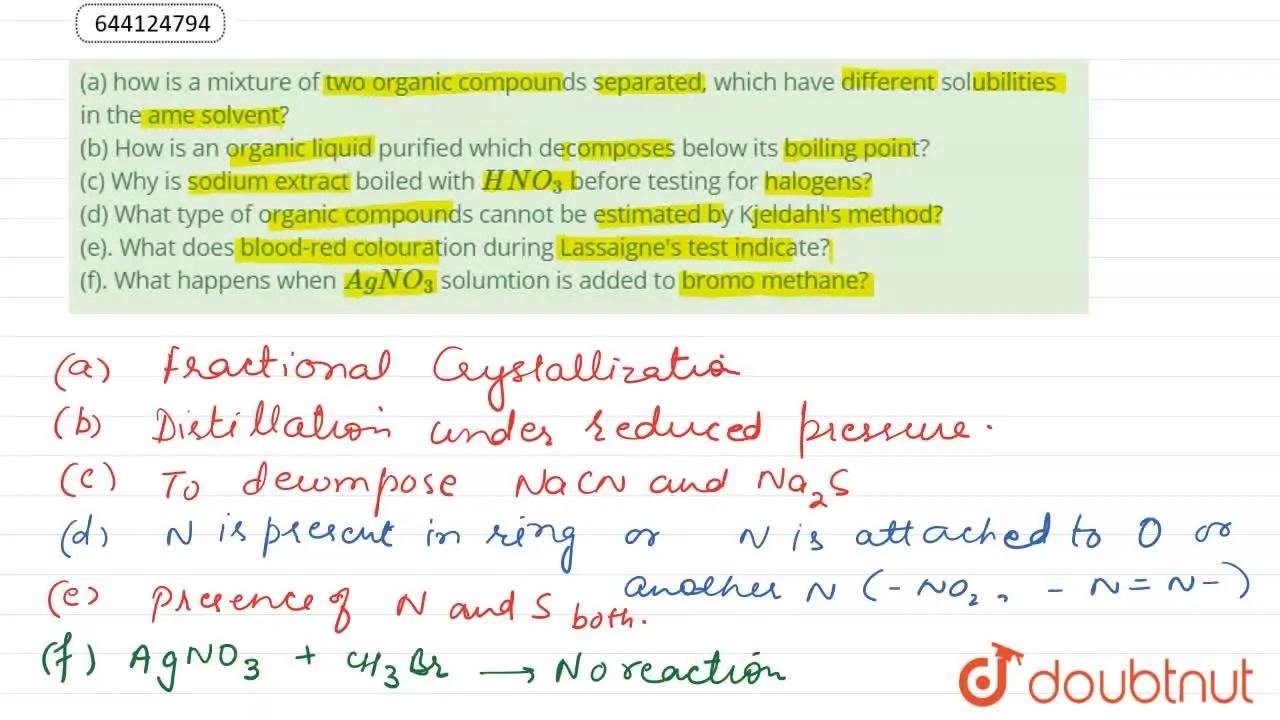(a) how is a mixture of two organic compounds separated, which have different solubilities in the ame solvent?
(b) How is an organic liquid purified which decomposes below its boiling point?
(c) Why is sodium extract boiled with HNO3 before testing for halogens?
(d) What type of organic compounds cannot be estimated by Kjeldahl's method?
(e). What does blood-red colouration during Lassaigne's test indicate?
(f). What happens when AgNO3 solumtion is added to bromo methane?
(a) by fractional crystallisation.
(b) Distillation under reduced pressure, i.e., vacuum distillation.
(c) to decompose NaCN or Na2S present in the Lassaigne's extract, otherwise these will produce white precipitate with AgNO3 and thus interfere with the test of halogens.
(d) Compounds containing N in the ring and those compounds in which N atoms is directly linked either at an O atoms or another N atom such as in azo (−N=n−) and nitro (−NO2) compounds.
(e). It indicates the presence of both N and S
(f). It would not give pale yellow precipitate of AgBr because CH3Br is a convalent compound and hence does not contain Br− ion. To get the precipitate of AgBr, CH3Br is treated first with aqueous KOH to get CH3OH and Br− and then the addition of AgNO3. It would now give the precipitate of AgBr partly soluble in NH3 or NH4OH
Related Playlists
- BOOK - CENGAGE CHEMISTRY ENGLISHCHAPTER - PURIFICATION OF ORGANIC COMPOUNDS AND QUALITATIVE AND QUANTITATIVE ANALYSISEXERCISE - Subjective Type11videos
PURIFICATION OF ORGANIC COMPOUNDS AND QUALITATIVE AND QUANTITATIVE ANALYSIS
- BOOK - CENGAGE CHEMISTRY ENGLISHCHAPTER - PURIFICATION OF ORGANIC COMPOUNDS AND QUALITATIVE AND QUANTITATIVE ANALYSISEXERCISE - Concept Application Type23videos
PURIFICATION OF ORGANIC COMPOUNDS AND QUALITATIVE AND QUANTITATIVE ANALYSIS
- BOOK - CENGAGE CHEMISTRY ENGLISHCHAPTER - PURIFICATION OF ORGANIC COMPOUNDS AND QUALITATIVE AND QUANTITATIVE ANALYSISEXERCISE - Assertion Reasoning Type5videos
PURIFICATION OF ORGANIC COMPOUNDS AND QUALITATIVE AND QUANTITATIVE ANALYSIS
- BOOK - CENGAGE CHEMISTRY ENGLISHCHAPTER - PERIODIC CLASSIFICATION OF ELEMENTS AND GENERAL INORGANIC CHEMISTRYEXERCISE - Exercises (Archives )Subjective4videos
PERIODIC CLASSIFICATION OF ELEMENTS AND GENERAL INORGANIC CHEMISTRY
- BOOK - CENGAGE CHEMISTRY ENGLISHCHAPTER - REDOX REACTIONSEXERCISE - Archives (Integers)1videos
REDOX REACTIONS
Similar Questions
The formation of blood red colouration during Lassaigne's test indicates the presence of
View SolutionSodium extract is heated with con. HNO3 before testing for halogens because
View SolutionThe Lassaigne's extract is boiled with dil. HNO3 before testing for halogens because
View SolutionThe compound that does not give a blue color in Lassaigne's test is
View SolutionThe LaSSaigen's extract is boiled with conc. HNO3 while testing for halogens. By doing so it :
View SolutionIn Lassaigne's test for N,S and halogens, the organic compound is
View SolutionThe function of boiling the sodium extract with concentrated nitric acid before testing halogens is
View SolutionExplain why an organic liquid vaporises at a temperature below its boiling point in steam distillation?
View SolutionQualitative test of halogens in an organic compound is made by :
View SolutionDuring sodium extract preparation for Lassaigne's test both N and S present in organic compound change to
View Solution


